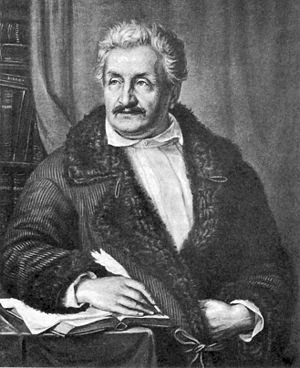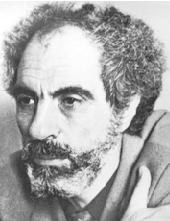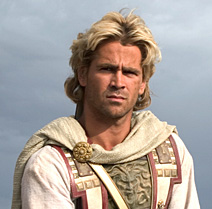One of the most interesting political develropments in the late 20th century, especially the 1990s, was the downfall of the Soviet Union and other affiliated Communist regimes in the eastern bloc. The break-up of the Soviet Union led to rise of wholly new nation states as did the fragmentaiton of former Yugoslavia.
One of the most interesting developments in the rise of these nation states was the rise of historical revisionism. Iran and its ancient Persian legacy is not the only ancient historical nation which has witnessed its historical icons and geographical names hijacked in the quest to manufacture new nation-states. Attempts at revisionism have been directed against other ancient historical nations such as Greece. The latter case can be clealry seen with respect Greece. Today the core of Greek identity is being challenged by revisionists who question the Greek origins (and legacy) of Alexander the Great.
Changing the name of Skopje to the Republic of Macedonia.
As noted previously, the Yugoslav Federation disintegrated in the 1990s. One of the former federated regions, which had a pre-dominantly Bulgarian-speaking Slavic majority, appropriated the ancient Hellenic geographical designation “Macedonia”. This region was previously known as “Skopje” – the actual Macedonia remains mostly in modern Greece. Not surprisingly, a number of Greeks have suggested that the Former Yugoslav Republic of Macedonia be referred to by its former name: Skopje.
The “Macedonia Resurrected” project not only threatens Greek territorial integrity, but the very basis of her culture and identity. Like anti-Iran Azerbaijan projects, there are now fraudulent “academic” projects endeavouring to prove that Macedonia was never historically Greek but “Macedonian”. Even the very Hellenic origins of Alexander and his father Phillip are being called into question.
The appropriation of geographical nomenclature has been immediately followed with claims to the Macedonian legacy of ancient Greece and all of the associated icons of that legacy. The Hellenic legacy of Phillip of Macedon, Alexander the Great and Macedonia is being rejected. This is a process called Retroactive De-Hellenization.
Again a quick study of archival documents contradicts the de-Hellenization of Macedonia. The term “Phillip” is derived from the Greek stem words “Phil” (to love) and “Hippos” (horses) – literally translated as “one who is affectionate to/loves horses”. “Alexander” is broadly translated as “the protector of men”. A handful of references below serve to illustrate the Hellenic legacy of Macedonia.
Herodotus commenting on the invasion of Greece by Darius the Great of Persia – Book VII 417-418
“…Now surely, as they all talk the same language, they ought to be able to find a better way of settling their differences…In any case, the Greeks, with their absurd notions of warfare, never even thought of opposing me when I led my army to Macedonia“.
Herodotus commenting on the Greek tribes of Dorians, Ionians, Aeolians, who were originally known as Macedones according to Herodotus – Book I 56
“…but the Dorians on the contrary have been constantly on the move; their home in Deucalion’s reign was Phthiotis and in the reign of Dorus son of Hellen the country known as Histiaeotis in the neighbourhood of Ossa and Olympus; driven from there by the Cadmeians they settled in Pindus and were known as Macedons; thence they migrated to Dryopis, and finally to the Peloponnese, where they got their present name of Dorians.“
A variety of other historial references may be produced. One prominet example is Quintus Curtius Rufus author of The History of Alexander. He was Roman senator and historian who most likely wrote at the time of Emperor Vespasian (r. 69-71 AD) or Claudius (r. 41-54 AD). He cited the Greek identity of the Macedonians in Quintus C. Rufus 3,3. His writings can be consulted on-line. Another is Diodorus (1st century BC), an ancient Greek historian who referred to the Greek identity of the Macedonians in Diodorus 17.67.1. Polybius (203-120 BC) was an ancient greek historian who wrote the text The Histories and refered to the Greek identity of the Macedonians in his Book IX 37.
There is virtually an endless stream of additional archival references, some which include:
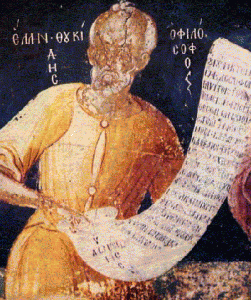
Thucydides (c. 460 B.C. – c. 395 B.C.) an ancient Greek historian, as portrayed in a fresco in the Church of Monastery of Filanthropinon (16th century). For references to the Greek identity of the Macedonians consult Thucydides 4.124.
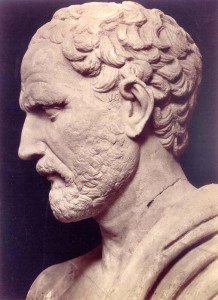
Demosthenes (384-322 BC). For references to the Greek identity of the Macedonians consult Speeches 11-20, the Letter of Philip.
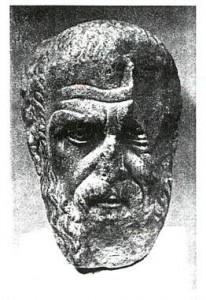
Arrian (ca. 86 – after 146) also known as Lucius Flavius Arrianus ‘Xenophon’ or Arrian of Nikomedia. For references to the Greek identity of the Macedonians consult Arrian 14,4,
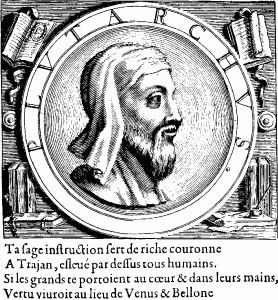
Plutarch (c. 46-120 AD) also known as Lucius Mestrius Plutarchus was a Roman historian of Greek ancestry. For references to the Greek identity of the Macedonians consult Plutarch 47,6 & 69,4.
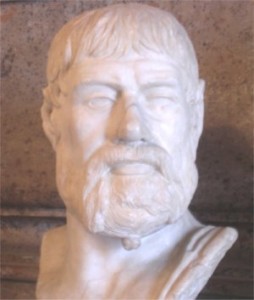
Pausanias was a Greek travellor and geographer of the second century AD. For references to the Greek identity of the Macedonians consult Pausanias 7.6.
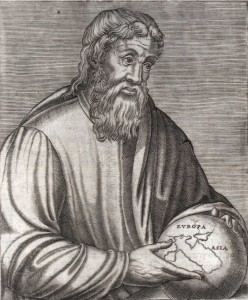
Strabo (63 BC – 24 AD), a Greek geographer, philosopher, and historian as depcited in the 16th century. For references to the Greek identity of the Macedonians consult Strabo 7.8.
“Alexander Mania“
The above-mentioned historical citaitons often matter little to nationalist ideologues intent on nation-building. It is as if by the stroke of a pen, the Hellenic legacy of Macedonia is to be erased by those harboring a political agenda.
An interesting article pertaining to this topic was produced by the Christian Science Monitor (March 20, 2008) entitled “2,300 years later Alexander-Mania grips Macedonia“. This illustrates how historial revisionism can rapildy transform into reality by those who wish to percieve it as such.
One of the quotes of the article states:
In an intense media campaign, locals are told that ethnic Macedonians are the proud direct descendants of Alexander, and thus a people responsible for spawning the white race of planet Earth, from the Caucasus “to the seas off Japan,” according to a public service spot on national TV.
Note how no acknowledgement is made with respect to the fact that the south Slavs migrated to Skopje centuries after the foundation of ancient Greece.

The facts on the ground today are being confused with ancient history. Politics is now overpowering neutral scholarship for this very purpose, as highlighted by this quote:
the new program deeply troubles many scholars and intellectuals here – who are being sidelined – for its promulgation of myth as truth. The new taxpayer-funded Alexander ideology has no serious texts.
As noted previously, Skopje (renamed Republic of Macedonia) is a former province of Yugoslavia. The process of nation-building now utilizes the re-writing of history by politicians and politically-motivated (or inspired or funded) historians. This has resulted in the inculcation of a new version of history in which the residents of former Skopje are linked to a de-Hellenicized “Macedonia” which claims many facets of ancient Greek culture, and territory. But Greece is only one exampel of an ancient civilization whose very historical identity is being put to the test.
“Nizami Mania“: An example of nation-building from a former Soviet Republic
Iran is also witnessing a number of its cultural and historical icons being “re-assigned” new identities (as non-Iranians) in the wake of Soviet and post-Soviet nation-building projects. One such figure is the Iranian poet Nezami Ganjavi (1141-1209) who is being appropriated for nationalistic purposes by the Republic of Azarbaijan which gained its independence as recently as 1990.
Azarbaijan did not exist as a nation distinct from Iran – it has historically been a province in Iran’s northwest since antiquity. The Republic that bears the same name (Azarbaijan) did not exist until 1918, and this nomeclature was applied to territories variously known as Arran, Albania as well as khanates such as Nakhchevan, Shirvan, etc.
In the effort to invent new nationalities in the Soviet Union, Joseph Stalin (1878-1953) ordered his “historians” to write new “history” textbooks that would help advance Soviet policies at home and abroad. Soviet ethno-engineering began to simplisically (and deliberately) classify historical figures from Albania/Arran (known as Republic of Azarbaijan since 1918) and the historical Azarbaijan in Iran as “Azerbaijanis“. The aim was to convey the message that these two regions were never distinct provinces of Iran, and that neither had any cultural, linguistic or historical associations with Iran. Note the parallels seen with Skopje being renamed “Macedonia” by former Yugoslavia to help the former make historical and territorial claims against historical Macedonia in Greece today.
The Soviets literally “erased” and expunged all archives before 1917 that distinguished Albania/Arran from Azerbaijan in Iran. But the falsifications did not end there. A key proponent of the Russo-Soviet assault on the historical identity of Iran was Joseph Stalin (1878-1953).
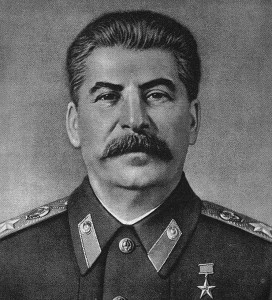
Joseph Stalin, one of the founders of the Soviet Union. Stalin began to cite many famous Iranian literary figures such as Nizami Ganjavi as “great national Azarbaijani literary figures”. No reference was made regarding their association and origins in Persia.
Staling even even so far as to say that Nezami Ganjavi:
“…must not be surrendered to Iranian literature, despite having written most of his poems in Persian.” (Kolarz, 1952).
In fact, Ganjavi wrote all of his poems in Persian and nearly all claims made by the Soviets and their successors in the region are false. Stalin’s statement was clearly aimed at rewriting history in the name of Soviet ethnic engineering. It was meant to convey the impression that (a) Nizami was Turkic in origin and (b) wrote his ‘other’ poems in Turkish. Post-Soviet Russian historians however have retracted the Communist-era propaganda by acknowledging that Nezami was:
“Nizamy (Sheikh Nizamoddin Abu-Mohemmed Ilyas ibn-Yusof) is the best romantic Persian poet (1141-1203)…” (From the Brockhaus and Efrona Encyclopedia, 1890-1900 published during the Czarist era).
For a thorough source of this subject consult:
Shnirelman, Viktor A. Memory Wars: Myths, Identity and Politics in Transcaucasia. Moscow: Academkniga, 2003 ISBN 5-9462-8118-6. Translation from Russian:
“By that time, already mentioned Iranian and Armenian factors contributed to the rapid azerbaijanization of historical heroes and historical political entities on the territory of Azerbaijan. In particular, in 1938, Nizami in connection with his 800-year anniversary was declared a genius(marvelous) Azerbaijani poet (History, 1939. Pp 88-91). In fact, he was a Persian poet, which is not surprising, because the urban population in those years was Persian (Dyakonov, 1995. page. 731). At one time it was recognized by all Encyclopedic Dictionaries of published in Russia, and only the Big Soviet Encyclopedia for the first time in 1939, announced Nizami as a “Great Azerbaijani poet” (Sr. Brockhaus and Efron, 1897. page. 58; Garnet, 1917. page. 195 ; BSE, 1939. p. 94)”.

The statue of Nizami Ganjavi (designed by Fuad Abdurahmanov) in Baku, Republic of Azarbaijan. Thanks in part to Soviet-era falsiification of texts and post-Soviet ethno-nationalist rhetoric there is a sincere belief in the region that this poet was not related to Iran, depsite the fact that his poetry praises ancient iran and his works have been written in Persian.
Professor Nazrin Mehdiyova, herself a historian from the modern Republic of Azerbaijan has noted that:
“…the myth
[of a North versus South Azerbaijan] was invented under the Soviets for the purpose of breaking Azerbaijan’s historical links with Iran. To make this historical revisionism more acceptable, the Soviet authorities falsified documents and re-wrote history books. As a result, the myth became deeply ingrained in the population [modern-day Republic of Azerbaijan, historically known as Arran until May 1918] and was adopted by the PFA [Popular Front of Azerbaijan] as part of the rhetoric.” (Mehdiyova, 2003, p.280).Despite the plethora of highly educated academics and historians in both the modern Republic of Azarbaijan and Russia, much damage has already been done as a result of decades of Soviet ethno-engineering. Many of the citizens of the Republic of Azarbaijan as well as elites in the political, economic and cultural spheres reject associations between Nizami Ganjavi and Iran.
A textbook case of this was the late Abulfazl Elchibey (1938-2000). Despite his training as a historian, Elchibey rejected all historiography and evidence of his nation’s historical associations with Iran. He believed that Ganjavi was not Iranian, despite his Persian poetry and themes related to pre-Islamic Persia. Similar processes can be seen today among a select group of Eurocentric Assyriologists and Near East experts with respect to ancient Iran (see below).
Abul-Fazl Elchibey who profoundly disliked Iran and called for its partition. In one of his viists to Turkey Elchibey referred to Iran as a “doomed state”.
The tragedy with Elchibey is that he failed to realize that much of what he believed in was the product of former Soviet ethno-engineering and nation-building. The same process has unfolded in the Republic of Macedonia which now lays claims to the core of Greek identity.
Vilifying Cyrus the Great: The case of Spiegel and the Daily Telegraph
Iran also faces profound challenges by Nordicists who are now questioning her very role in history. Facing particular venom since the mid to late 1970s by a select group of western Assyriologists and ancient Near East historians is Cyrus the Great (558-330 BC), who has been favorably cited as a benevolent ruler according to ancient Greek, Babylonian and Hebrew texts.
Not so according to an article which appeated on July 15, 2008 in the German Spiegel Magazine by Spiegel reporter Matthias Schultz in which he claimed that the entire history of ancient Persia’s Cyrus the Great and his benevolence in history is false.
Spiegel reporter Matthias Schulz has characterized Cyrus the Great as a bloodthirsty conqueror and the entire history of his reign as “propaganda” of the former Pahlavi regime. Reporter Schulz is not alone; there are a number of historians of ancient Iran who share these views and have been attempting to re-write the history of Cyrus and much of ancient Iran. Much of these writings attempt to distort the ancient texts, ignore archaelogical findings and propose novel hypotheses.
A few days afterward on July 21, 2008, Harry de Quetteville reinforced these sentiments in his article entitled “Cyrus Cylinder’s Bill of Rights is just Propaganda” published by the Daily Telegraph.
Reporter Schulz is in fact only a messenger by simply quoting from a series of writings (1970s-Present) written by his western colleagues active in ancient Near Eastern Studies. While Mr. Schulz has certainly succeeded in making himself unpopular to the Iranian people, it is not altogether fair to focus all the attention on his person. The real basis of his article can be traced to the aforementioned (select) group of western Assyriologists and ancient Near East historians.
The thinking processes seen by anti-Cyrus (or Persia) revisionist historical writers is strikingly similar to the anti-Greek propaganda cited in the aforementioned Christian Science Monitor article. The latter cites a 9-minute TV broadcast stating that:
Our neighbors distributed thousands of books across the world, containing false history and portraying a wrong picture about Macedonia
There is a genuine belief by the anti-Greek revisionists that somehow a thousands year long conspiracy has been in place (presumably by Greeks) to create a “false history and portraying a wrong picture about Macedonia“. Likewise Nordicism argues that the history of ancient Iran and Cyrus the Great in particular is all some sort of conspiracy or “Shah propaganda” – this view is clearly stated by Spiegel reporter Mr. Schulz and Mr. De Quetteville of the Daily Telegraph.
What is strange however is that many of these historians (including some who are completing their Post-Doctoral studies) insist at dismissing (or re-interpreting) ancient historical references that contradict the theories that have been narrated since the 1970s.
In concordance with Soviet-era nation building processes, all established history that contradicts historical revisionism is portrayed as false. In the case of Iran, these, as noted already, are claimed to be propaganda narratives written during the reign of the former Pahlavi regime.
The precedent of Fallremayer and Nordicism
The attempt to somehow de-link Alexander from the Greece of today is nothing new. Nordicists have attempted to portray “Ancient Greeks” as being unrelated to the Mediterranean Greeks of today, and in that endeavor Alexander has been (for lack of a batter term) “Nordified“.
This view was championed by the Austrian Hellenicist, Professor Jakob Phillip Fallmerayer (1790-1861), in the 1830s, who noted that
“…not a drop of pure Greek blood runs in the veins of modern Greeks…”
Professor Jakob Phillip Fallmerayer (1790-1861), He promoted the thesis that ancient Greeks were predominantly blonde, like present-day Scandinavians and Northern Europeans. Fallmerayer’s writings, which could be construed as racist, state that the people of ancient and modern Greece have no relation. According to this thesis, “ancient” Greeks were the “true” Greeks – these being wholly unrelated to the predominantly Mediterranean people of Greece today. Fallmerayer’s divergence from reality is illustrated by the fact that he never visited Greece during his lifetime. This is identical to a select number of contemporary historians who wish to re-write the history of Cyrus the Great, yet are unable to speak or read modern Persian.
For further discussion on these issues kindly consult:
Felipe Fernandez-Armesto: Guide to Peoples of Europe, (especially pages 207-216).
Published in London by Times Books in 1994. ISBN: 0-7320-0624-5Nordicism towards Greece and ancient Iran (Persia)
The Fallmerayer school of thought is alive and well to this day. This is vividly seen in the Nordicist view of Greece exemplified today in modern-day entertainment. This was demonstrated in the movie Alexander in which the ancient Greek conquerer was presented as a flaxen-haired warrior:
The famous historical depiction of Alexander in the Pompei Mosaic however challenges the Hollywood view (shared by some academics as well)
Alexander the Great (356-323 BC) as portrayed in the Pompei Mosaic.
The movie also provided false images of Iranians, a process taken to the extreme by the later production entitled “300” in which ancient Iranians were portrayed as ogres and monsters.
To this day, many in the west are not aware that Alexander the Great may not have been as “Nordic” as is generally supposed.
In the case of ancient Greece, Nordicism (a la Fallmerayer) makes clear that Greek culture has been founded not from the Mediterranean theatre but from settlers hailing from northwest Europe.
Likewise, Nordicism shuns any possibility that the concept of human rights has an Oriental or “eastern” connection. This is made explicitly clear by Harry de Quetteville in the aforementioned Daily Telegraph article which stated that:
UN’s adoption of the cylinder [as a Human Rights document] stemmed in part from a desire to claim some eastern roots “when it is so Western in its philosophical underpinnings”.
Harry de Quetteville . He declares that much of the favorable history of ancient Iran is to be simply dismissed. Mr de Quetteville’s writings symbolize the revival of Orientalism in both the media and (some) academic circles.
De Quetteville further adds:
For all the criticisms of the Cyrus cylinder, it is unlikely to change perceptions of it in Iran, where Cyrus and the cylinder are regarded with intense national pride. It is a source of great pride …but like many things said about Persia in Iran, it has to be taken with a big pinch of salt.
Note the parallels between the Nordicism of Fallmerayer with respect to the Greeks and those of De Quetteville (and a number of like minded historians) with respect to ancient and modern Iran.

